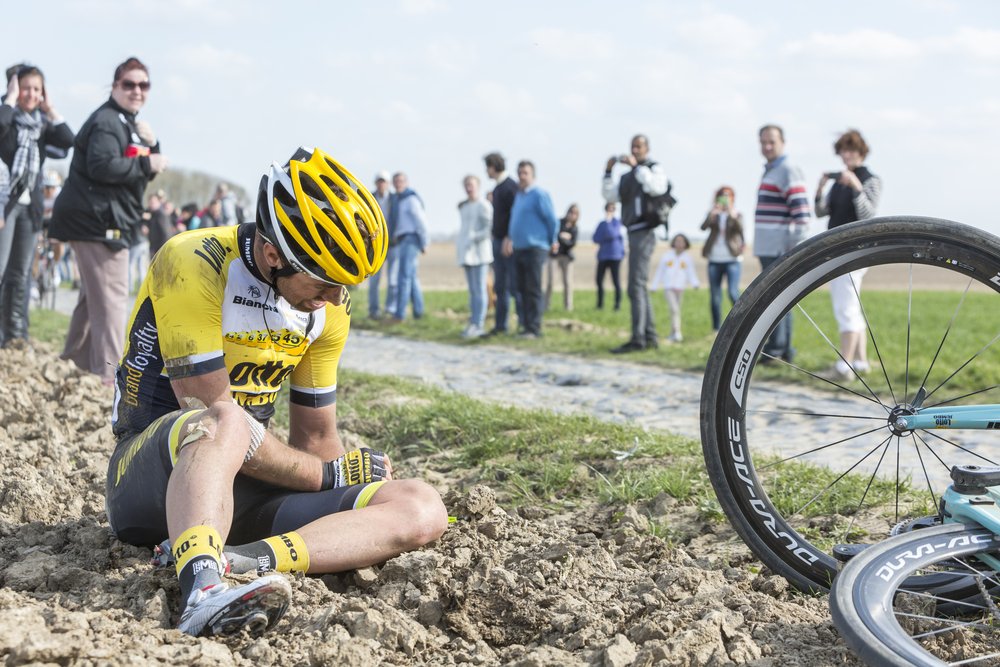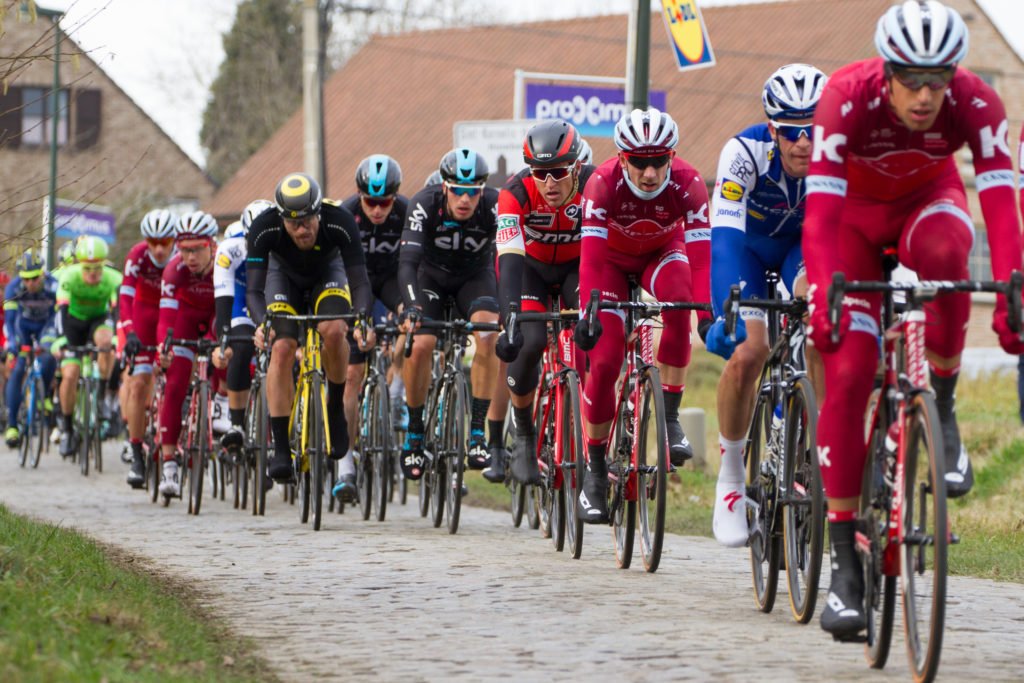The cobbled classics cycling season has just arrived which means (in my opinion) the most exciting races of the year. The Spring classics test riders to their absolute limits, racing on the toughest terrain and against the most challenging conditions of the calendar, all to be the rider with the honour of lifting a cobblestone above their heads as the victor. Well, that and the massive prize pots.
With the cobbled classics comes the cobbled classics sportives; a chance for amateurs to race a professional course and earn real bragging rights among their club mates; “Think ‘L’Etape Du Tour’ was tough this year? You should have been at Roubaix!” But if this is your first year riding on Belgian cobbles, what should you be aware of before you set off? Is there any last minute preparation for the Paris-Roubaix challenge or Tour of Flanders sportive you need before race day?

Tom Van Asbroeck at the Paris-Roubaix 2015
Riding the Pavé
The number one goal while riding cobbles is to remain upright, and not end up sitting in a puddle by the side of the road. If you’re a mountain biker, you’ll likely be more prepared for the cobbled roads than most.
The key to keeping your balance on rough, bumpy surfaces is maintaining a decent speed while keeping a constant pressure on the pedals. Cycle with a medium cadence on as big a gear as you can maintain, and avoid freewheeling or spinning in a too-low gear when the road gets rough.
What to Wear
Don’t try to predict the weather. Paris-Roubaix and the Tour of Flanders sportive take place in early April, so glorious sunshine is just as likely as miserable cold and rain which could easily turn to snow hence ‘dressing in your Flandrian Best’, but given that we had the warmest February day on record last week, it’s anyone’s guess what the weather will be like.
You want to be travelling with a full gamut of clothing; arm and knee warmers plus a waterproof gilet if you get lucky, or full gloves, jackets, bib-tights and booties if you don’t.

Omloop het Nieuwsblad 2015
Should you take your own bike?
The cobbled classics have a reputation for being bike breakers, and many will rent something for the weekend rather than risk their own on the cobbles. The truth is if you have a carbon frame, it should be more than strong enough to take the abuse. Just leave your deep section, carbon rims at home. They aren’t going to make you any quicker on a Classics route, and are a definite weak point due to their small contact area with the road. Stick to a pair of robust aluminium wheels. Check out our blog on travelling with bikes.
Inevitable product placement: We provide bicycle insurance that covers accidental damage as standard, including on Belgian Cobbles. We even cover your bikes in transit. It is available for just the event, or the entire year, and you should definitely check it out.
Preparing your bike for a Cobbled Classic Sportive
So you’ve decided to take your own bike. Roadcyclinguk have a great article looking at how the pros have their bikes setup for riding the Classics, but what about us mere mortals?
If you have a cyclocross bike, the upright riding position and space for wider tires is going to be a great advantage, but you can prepare your road bike without spending a fortune on new parts. Start by reducing your tire pressure. The pros are riding with between 70 and 80 psi, but unless you have the luxury of riding on tubs this is almost certainly going to lead to pinch flats. Try around 90 and see how the bike feels.
On the topic of pinch flats, Cycling weekly published a handy article on converting inner tubes to work with tubeless tire sealant. While an interesting idea, when a member of the YJ team tried it out last winter we just ended up with white goop all over the office carpet. Your results may, hopefully, vary.
If you have upgraded to a pair of carbon wheels, you are going to want to swap back to the aluminium pair your bike came with, or borrow a spare pair. Running at a low tire pressure on rough surface presents the danger of your wheel rim contacting the edge of a bump as you ride over it. While an aluminium rim will likely bounce off, this is exactly the sort of collision that will crack a carbon wheel.
If you have the option of running a wider tire then use it. This will not only give you more grip on slippery surfaces, but also absorb a little more of the vibration. And make sure you are using all weather winter tires, not your summer slicks.
Most of the vibrations from the road will be transferred through your handlebars, and after a few kilometres of cobblestone you will be feeling the burn in your wrists and forearms. Most of the sportive riders will add a second layer of handlebar tape over what is already there to try and provide a bit of extra padding. Aim to get the thickest stuff you can find, or alternatively you can stick gel pads under the bar tape where you will be holding the bars. Your LBS will be able to help you with this.
Every Spring Classic sportive ends with hundreds of water bottles lining the course. They aren’t from enthusiastic riders casting their bidons aside to save weight before a sprint (well… some are), but rather from the bottles working their way free from the cages due to the rough roads. The spindly carbon bottle cage you bought because it was only 5 grams isn’t going to be good enough to keep hold of your water bottles, so make sure you swap them out for something a little more substantial.
Finally, you won’t see a rider in the pro race that isn’t using a chain catcher. There seems to be a perception that they are a little uncool, but if it stops your chain slipping behind your chain ring when it inevitably jumps off, you’ll be glad of it. We would suggest keeping one on throughout the year. It’s amazing how many bikes we have seen where the chain has fallen behind the chaining, the rider has (for some reason) kept peddling, and then torn a great big hole through either the bottom bracket or the chain stay.
Travel Insurance
The Cobbled Classics can be dangerous events, so you should really consider taking out some form of travel insurance. Most are timed events so are considered bicycle races by insurers, meaning the vast majority of policies you get from your bank, employer, etc. will exclude cover.
We provide a travel insurance for cyclists which will automatically cover the costs of emergency medical care and repatriation if the worst should happen while riding or racing overseas.
If you search for tips on riding the cobbled classics, you’ll find no end of forums where veterans have shared their wisdom. What would your advice to a Spring Classic Sportive first timer be?